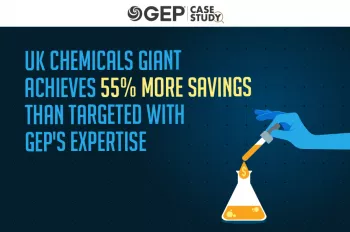What do enterprises expect from their procurement teams today?
More savings on spend of course, but that’s just table stakes. How can they be the strategic business partners and trusted advisors that enterprises want them to be?
In the latest issue of GEP’s Insights from the Top, Akash Gupta, CPO of Principal Financial Group, shares how procurement has evolved as a strategic enabler of innovation and growth at his company. He also talks about how procurement can help enterprises navigate through the global crisis and deliver long-term, sustainable value. Read on.
How is procurement supporting your company’s mission?
First and foremost, procurement must enable our firm’s core mission, which is delivering differentiated customer service to help enable financial security. We help people protect what’s important to them — their retirement, financial security, life, loved ones, and assets — and success of financial services companies is driven by the quality of customer service.
We create value across the entire financial services supply chain. From helping distribution partners with their needs to the right product capabilities to partnering with operations to deliver the product and service in an efficient and nimble way. By leveraging our supply chain, we help the organization react effectively to customer needs and market trends.
What are the key traits of a high-performing procurement organization?
There are three core interconnected qualities of a world-class procurement function. First, operate as an internal advisory group and not only as a purchasing group. This will ensure procurement brings a strategic approach and mindset. That we understand the business environment and organizations’ goals, both in the short- and long-term, and align our activities to the goals.
Second, operate using a balanced scorecard, tracking multi-faceted contributions. Procurement is not simply about cost. Procurement is a strategic enabler of the company’s growth and innovation, as well as efficiency. In this moment of time, with the economic uncertainty, procurement’s priority is to enable the organization to become more cost-efficient. But if you only focus on delivering cost savings, it may impede value creation. Nor is it sustainable. This is something that the procurement community can generally be better at.
Third, ensure strong alignment with finance, and provide the organization with real-time visibility into spend across lines of businesses, products and business units to managed categories.
How can procurement positively impact claims spend, a “sacred cow” at insurance companies?
Policyholder benefits represent the largest part of any insurance company’s total costs and are the reason why customers buy our products and services. Claims is a key process that elevates a company’s reputation and builds customer loyalty.
The challenge is that at many insurance companies, the relationship between chief procurement officer and chief claims officer is often strained. Claim leaders are naturally suspicious of procurement, since their assumption is that we’re going to look at indemnity and benefit cuts, which flies in the face of delivering superior customer satisfaction.
The right metric is improving the customer experience. Procurement should look at how we use technology to improve the customer experience and drive top-line growth and innovation. Procurement should partner with the business on improving the process of adjudicating and accelerating customer claims to improve our customer experience, at the same time driving precision and fraud detection using AI and technology.
How does procurement deliver value beyond cost cutting?
By acting as a strategic advisor to the business, and using our buying power, we can provide greater economic opportunities to minority-owned companies and foster greater diversity among suppliers and partners. Procurement is also best placed to drive enterprise transformation. Procurement can easily be one of the first departments to drive an enterprise-wide approach. Our success at creating centers of excellence to serve entire organizations is the poster child for all business functions. We’re showing the way for departments and functions to operate across all business units, product lines and geographies.
How is procurement helping companies respond to lockdowns, uncertainty and disruptions?
Internally, as a team, we deliberately became more agile. We’re doubling down on areas that provide tail winds from the last few months to make them sustainable.
Externally, we’re laser focused on our supply chain, constantly monitoring our partners to ensure business continuity for key services. More broadly, we’re keeping our spend elastic, so we can scale or shrink our supply chain quickly to meet customer demand and organizational priorities. The pandemic has also been an ideal time to fast-track our digital adoption, which enables us to both manage costs and improve our clients’ experience.
The pandemic is accelerating digital adoption, but what are your top frustrations with digital transformation projects?
For procurement and supply chain, an integrated, one-stop shop solution is challenging to find. Technology providers will tell you they can do it all, but it’s simply not the case. A bigger frustration is that providers lead with their technology tools, and not outcomes. They focus on features and functions, and not intelligence and insights. For instance, procure-to-pay technology providers state that their solution will save leakage, but they’re unable to track and be accountable for their commitments. Organizations want to buy outcomes, not just technology tools. Procurement is focusing on delivering business results, not simply managing digital implementations.
What are you seeing that’s exciting, or concerning, for procurement in the coming year?
This is a pivotal moment for procurement. In the last couple of years, it has become one of the top priorities for the C-suite. Because we’re one of the few functions within a company that can deliver quick and tangible value, procurement provides the executive leadership team with the shortest time to impact their organization in a meaningful way. Moreover, we are an aggregator of value across the entire organization. Unlike a product or one market, we can positively impact every line of business, function and geography.
How can CPOs partner with the business to drive lasting change?
Align the procurement model to the overall business strategy, product portfolio and the culture of the organization. Unless we tie our initiatives to measurable imperatives, we’re not going to drive sustainable change. We also need to understand what the organization is ready for and secure buy-in from middle management — not just the C-suite. Middle management, not executive leaders, are the ones who are in the position to explain what may or may not work. Securing support from middle management is key because if they’re brought in, they’ll help drive adoption across the organization.
What advice would you offer a peer about procurement in financial services?
Unlike manufacturers and distributors, financial services organizations don’t buy commodities. Invest the time in learning the business. Auto or home is entirely different from annuities, which is different from funeral insurance. We must speak the same language of our organization. In the long run, business is the language of procurement. Above all, be bold in driving change. We’re not going to be successful at driving innovation if we don’t make substantive promises and own them.


